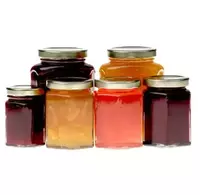Jam

Perhaps not everyone in childhood read the beautiful and kind children's book of the Swedish writer Astrid Lindgren from the trilogy of the same name "Carloson, who lives on the roof. " But the Soviet cartoon "Baby and Carlson" watched, we think, all without exception. Remember that was the main delicacy of Carloson "men in their prime, " of course, in addition to goodies and cakes? That's right, jam.
The name of dessert and vitamin-fruit delicacy occurred in ancient Russian times, when they began to cook the first jam. If we recall the classic composition of jam (berries or fruits, sugar and water), we will see how the old Russian delicacy differed from the modern version. In ancient times, berries and fruits in Russia were brewed not in water, but in sweet molasses or honey.
Moreover, there were sometimes very unusual combinations in the ingredients of jam. For example, radish jam, with nuts, often made more familiar and familiar floral jam (rose hips, dandelion). The proven time and undeniable benefit of jam lies in the natural vitamin component of this product.
The useful properties of jam increase many times if you make it not with sugar, but with honey. Apparently, due to the presence of sugar in the recipe, many people consider the calorie content of jam to be rather large. This is not entirely true, since the sugar level in jam can be changed or not used at all.
The calorie content of jam made from the same berries or fruits can be completely different. For example, there are naturally sweeter berries in which you can add less sugar, thereby changing the calorie content of the product. There are an incredible number of varieties of jam, it all depends only on the imagination and taste preferences of the hostess.
The following types and useful properties of jam are better known. Currant berries are made of jam, which has excellent anti-food properties due to the high content of vitamin C. Strawberry jam is considered a natural antioxidant, and raspberry is rich in calcium and iron, and is also considered the second "aspirin" for colds. Blueberry jam is rich in vitamins of group B, PP, C, A (carotene), iron and organic acids, which affects vision and human health in general.
The benefits of jam
The benefit of jam lies not only in its rich vitamin composition, but also in its excellent saturating properties. Agree, few people can eat 10 spoons of jam at a time, and chocolates, which are much more high in calories, sometimes absorb kilograms. The interesting thing is that there is not only benefit, but also harm from jam.
Jam harm
With all the content of nutrients and vitamins, jam contains a large amount of carbohydrates. On average, 68% of carbohydrates fall on 100 grams of the product, this is the main harm of jam for a good figure and human health, since large consumption of high-carbohydrate food can contribute to the development of diabetes. Therefore, do not lean on jam, using this, certainly useful in moderation, product as an alternative to chocolate or other sweets.
jam 254 kCal
The energy value of jam (Ratio of proteins, fats, carbohydrates - ju):
Proteins: 0.4 g (~ 2 kCal)
Fats: 0.3 g (~ 3 kCal)
Carbohydrates: 68.2 g (~ 273 kCal)
Energy ratio (bj | y): 1% | 1% | 107%
 Español
Español Français
Français Português
Português Русский
Русский 简体中文
简体中文 繁體中文
繁體中文 日本語
日本語 한국어
한국어 العربية
العربية Türkçe
Türkçe Қазақ
Қазақ Deutsch
Deutsch Italiano
Italiano Українська
Українська
